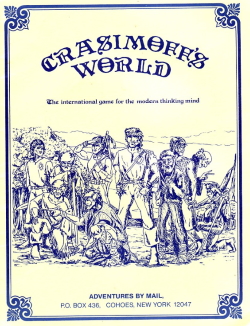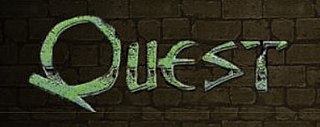
A play-by-mail game is a game played through postal mail, email or other digital media. Correspondence chess and Go were among the first PBM games. Diplomacy has been played by mail since 1963, introducing a multi-player aspect to PBM games. Flying Buffalo Inc. pioneered the first commercially available PBM game in 1970. A small number of PBM companies followed in the 1970s, with an explosion of hundreds of startup PBM companies in the 1980s at the peak of PBM gaming popularity, many of them small hobby companies—more than 90 percent of which eventually folded. A number of independent PBM magazines also started in the 1980s, including The Nuts & Bolts of PBM, Gaming Universal, Paper Mayhem and Flagship. These magazines eventually went out of print, replaced in the 21st century by the online PBM journal Suspense and Decision.
Starweb is a closed-end, space-based, play-by-mail (PBM) game. First published by Flying Buffalo Inc. in 1976, it was the company's second PBM game after Nuclear Destruction, the game that started the PBM industry in 1970. Players today can choose a postal mail or email format. Fifteen players per game assume one of six available roles and explore and conquer planets within a universe comprising 225 worlds. The object of the game is to attain a predetermined number of points which are generated by various actions during gameplay. Multiple game variants are available. Starweb is still available for play as of 2021 through the company Rick Loomis PBM Games.

Legends is a turn-based, role-playing game with a medieval setting. It is currently published in English by Harlequin Games. Jim Landes—owner of Midnight Games, the game's first publisher—began developing the game in 1984, eventually publishing it in December 1989 as a play-by-mail (PBM) game after over a year of playtesting. The initial game comprised a module and game system built on the publisher's existing game, Epic, and was run briefly as Swords of Pelarn before publication as Legends. The first of multiple game modules was Crown of Avalon, which allowed up to 200 players per game. Demand by 1991 was "incredible" according to Bruce R. Daniel in White Wolf. Games could be lengthy, initially between three and ten years of play, settling into an average of three years by 2002.
Middle-Earth Play-By-Mail, is a turn-based, strategy play by email and play-by-mail game set in the world of J.R.R. Tolkien’s The Lord of the Rings and The Hobbit, including elements from ICE's Middle-earth Role Playing under licence from GSIL. The game is now run as Middle-earth Strategic Gaming by Middle-earth Games, Ltd.

Heroic Fantasy is a computer-moderated, dungeon crawl play-by-mail game. It has been active since 1982 when it was published by Flying Buffalo. The initial edition involved nine dungeon levels. Flying Buffalo published subsequent editions due to challenging gameplay initially, eventually limiting the game to four dungeon levels with a fifth outdoors level where players can assemble an army and capture one or more castles. The game is open-ended; gameplay continues until players decide to stop.

Hyborian War is a play-by-mail game published by Reality Simulations, Inc. It takes place during the Hyborian Age in the world of Conan the Barbarian created by Robert E. Howard. The game has been continuously available for worldwide play since its inception in 1985 and has changed little in its overall format. It uses a computer program to adjudicate player orders. Although it relies on postal mail or email and has turnaround times which are relatively long for the digital age of video games, Hyborian War has remained active into the 21st century.
Paper Mayhem is an out-of-print play-by-mail (PBM) game magazine that was published in Ottawa, Illinois. The staff published the initial issue in July 1983 and the magazine ran until mid-1998. Its format was 40 pages published six times per year. The magazine was the most well-known of the play-by-mail periodicals of the period, providing articles and reviews of play-by-mail games, as well as reader-informed ratings of play-by-mail companies, game masters (GMs) and games, both intermittently and on an annual basis. The magazine, along with its long-time editor-in-chief, David Webber, was influential in the play-by-mail community, even echoing into 21st century play-by-mail activities. The publication ceased suddenly in mid-1998 following the unexpected death of Webber.

Crasimoff's World is a play-by-mail (PBM) game that was first developed by Kevin Cropper in 1980. It is regarded as the first fantasy role-playing PBM game.
Fall of Rome is a play-by-mail strategy wargame that was published by Enlightened Age Entertainment. Set in the period after Roman times, it involved covert action and combat. The game won the Origins Award for Best Play-By-Mail Game of 2004.
Lords of the Earth (LOTE) is a play-by-email game, first published by Thomas Harlan in 1983 during a growing era of PBM games. Initially played by postal mail, the game featured mixed moderation—computer moderated with some human assistance. By 2002, the publisher processed turns by email (PBeM). Lords of the Earth comprises multiple campaigns, each one a separate game. Campaign 1 is the oldest, set in the mid-1800s in the "Age of Air and Steam". Other campaigns begin from 2000 BCE to 1400 CE. Settings were global in scale, with one campaign featuring an outer space setting.

Victory! The Battle for Europe is a closed-end, military strategy, play-by-mail (PBM) wargame. The game was first published by Rolling Thunder Games, Inc. in 1991 after a period of initial growth in the PBM industry. The game centers on Europe while including parts of North Africa, the Middle East, the United States, and Canada. Forty players start each game with equal resources among countries, although geography causes differences between starting positions. Games last for about three years each. The game received positive reviews and rankings in the PBM magazine Paper Mayhem in the 1990s, including tying for second place in its Best PBM Game of 1995 list.

Quest is an open-end, fantasy, play-by-mail (PBM) role-playing game. Initially released in the United Kingdom in 1991, by Adventures by Mail, it later became available for play in the United States, Australia, and other countries in Europe. The game has a First and Second Age, initially comprising about twenty worlds of up to 1,000 parties controlled by players. After the year 2000, the worlds consolidated into four. The current publisher is KJC Games.
KJC Games is a gaming company that publishes play-by-mail (PBM) games. Kevin Cropper started the company in 1981. It published PBM games such as Crasimoff's World, Earthwood, and It's a Crime.
Lizards is a closed-end, computer moderated, play-by-mail role-playing wargame.
Epic is a computer-moderated, fantasy play-by-mail (PBM) game.
War of the Dark God is a closed-end, computer-moderated, play-by-mail fantasy wargame.
Galactic Power is a closed-end, play-by-mail game. It was published by Vigard Simulations.
Crack of Doom is an open-ended, mixed-moderated, play-by-mail game. It was designed and first published as Crack of Doom by Duane Wilcoxson and Debbie Leonard of Advanced Gaming Enterprises in 1986. They published Crack of Doom II in 1997 which ran alongside the first version. By 1997, Crack of Doom II was running under license in the United Kingdom, first under Phildee Enterprises and later under Harlequin Games. These were fantasy role-playing games, comparable in gameplay to Advanced Dungeons & Dragons. The games were reviewed in various gaming magazines in the 1980s, 1990s, and 2000s, receiving generally positive reviews.
Crystal Island is a closed-end, mixed-moderated, heroic fantasy play-by-mail game. It was published by Saul Betesh. Similar in gameplay to Advanced Dungeons & Dragons and Tunnels & Trolls this solo adventure was under way by 1990 as one of three starter games within Betesh's "Draconian System" which featured the expansive multi-player fantasy game DragonsKeep. Players generated a character for role-play with various attributes and skills, advancing by amassing experience points to increase levels. Players accomplished their goal by acquiring three keys and traveling to the Crystal Tower to complete a quest. The game received generally positive reviews in gaming magazines in the early 1990s.






